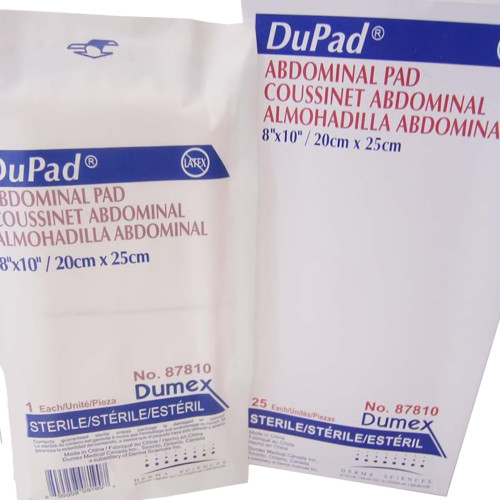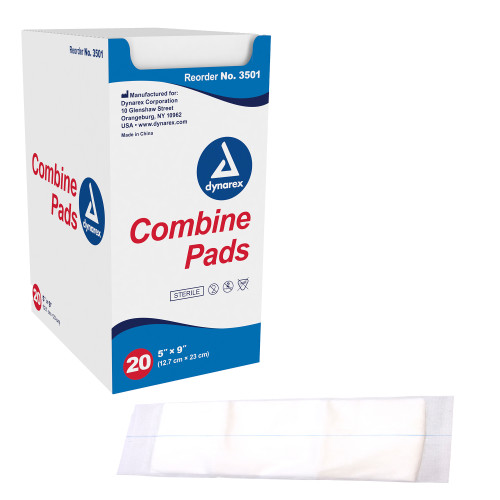-

CareStock
CareStock Abdominal Pad Sterile 8 x 10"
Add Carestock sterile nonwoven cellulose abdominal pads to your wound care supplies to seal off the abdominal wound area and lower the risk of infection at the wound site. Made up of a nonwoven outer fabric combined with inner cellulose tissue, these...
As low as $11.50 -

CareStock
CareStock Abdominal Pad Sterile
Add Carestock sterile nonwoven cellulose abdominal pads to your wound care supplies to seal off the abdominal wound area and lower the risk of infection at the wound site. Made up of a nonwoven outer fabric combined with inner cellulose tissue, these...
As low as $8.49 -

DuPad
DuPad ABD Pad - Sterile, Absorbent Abdominal Pad for Wound Care
A three-layer abdominal pad that wicks away exudate, prevents strikethrough and has a system for absorption.Abdominal pads are filled with cellulose fibers, making them super-absorbent The fibers quickly absorb and disperse fluids laterally, to prevent...
As low as $18.36 -

Curity
Curity Abd Pads, 3-Ply Abdominal Padding First Aid Supplies
Abdominal pads by Curity are designed for maximum absorbency and comfort. Indicated as primary dressings for abdominal or other large incisions; and large trauma sites. Also for secondary dressings over heavily exudating wounds; they cushion and protect...
As low as $12.83 -

Covidien
Dermacea Abdominal Pads - Sterile, Non-Woven ABD Wound Bandage
Dermacea abdominal pads are designed for maximum absorbency and comfort. Indicated for primary layer for heavily exudating wounds; secondary layer for heavily exudating wounds; padding for pressure points; and anywhere high absorbency is needed.Four...
As low as $14.46 -

Dynarex
Dynarex Abdominal Wound Pad - Sterile Combine ABD Bandage
Abdominal pads (also known as combine pads) are designed for use where high absorbency is needed for heavy draining wounds.The sterile combine pads have an outer cover constructed of a soft Nonwoven material, filled with a fluffy inner filling which...
As low as $9.73 -

Dukal
Dukal Abdominal Pad, Sterile, Non-Woven ABD Padding for Wounds
Create a moisture barrier on abdominal applications using this Dukal Rectangular Sterile Abdominal Pad, which features an outer facing that wicks moisture toward the cellulose core, where it's then quickly absorbed and dispersed. The edges of the pad are...
As low as $12.98 -

Hartmann
Hartmann Sorbalux ABD Pad - Sterile, Absorbent Abdominal Pad
Sterile absorbent abdominal pad can serves as a primary or secondary dressing for heavily draining acute and chronic wounds.Secures dressings in place with minimal risk of slipping or constriction Clings to itself when overlapped Conforms to body...
As low as $10.93 -

DuPad
DuPad Abdominal Pad - Sterile, Absorbent ABD Wound Bandage
A three-layer abdominal pad that wicks away exudate, prevents strikethrough and has a system for absorption.Abdominal pads are filled with cellulose fibers, making them super-absorbent The fibers quickly absorb and disperse fluids laterally, to prevent...
As low as $16.72 -

McKesson
McKesson Abdominal Pads - Sterile, Combine ABD Wound Bandage
Constructed with a Nonwoven outer fabric and inner cellulose tissue, this McKesson Rectangular Sterile Nonwoven Cellulose Abdominal Pad creates a reliable moisture barrier that absorbs quickly without linting. The pad wicks moisture quickly to help keep...
As low as $8.05
ABD Gauze Pads

ABD Gauze Pads
When it comes to wound care, it’s all about healing the wound in the fastest and most efficient way possible while preventing infection and additional injury. Due to wound exudate, or excretions, it is often advisable to use a sterile abdominal gauze pad as a part of that process.
What are abdominal gauze pads?
Abdominal gauze pads, known as ABD pads, are non-woven, thick, and absorbent. While called abdominal dressings because they are often used for post-surgical, heavily draining wounds to the abdomen, they work well for any heavily draining area.
The construction of a sterile abdominal gauze pad absorbs and disperses this drainage by isolating the area using an adhesive border that encloses the wound completely.
What Material are abdominal gauze pads made of?
Abdominal pads are made with nonwoven outer fabric and an inner layer of cellulose tissue that is highly absorbent. The cellulous tissue has a hydrophobic material (water repellent) backing to waterproof the wound and to keep the drainage from escaping.
The bandage is bordered on all sides by adhesive to keep the wound isolated and free from infection. There are latex-free options as well.
When are abdominal gauze pads used, and in what applications?
You use abdominal gauze pads in two different ways. They can be a primary dressing for normal draining wounds, such as abdominal wounds, in which case they contact the wound directly.
For high-discharge wounds, there can be a secondary dressing over a transparent dressing that contacts the wound. As a secondary bandage, an abdominal wound pad can be sterile or non-sterile. The secondary dressing can then be changed without removing the primary dressing and further compromising wound integrity.
How you will use an abdominal dressing, whether primary or secondary, depends on the type of excretions, the amount of discharge, and the size of the wound.
What sizes do abdominal gauze pads come in?
Abdominal gauze pads come in various sizes and should be chosen by selecting a bandage that covers the wound area but doesn’t allow for a lot of extra space around the wound. Care should be taken that the bordering adhesive doesn’t contact the wound and further compromise the skin there.
Common sizes include:
5 X 9 Inch
7-1/2 X 8 Inch
8 X 10 Inch
What are the pros and cons of an abdominal gauze pad?
Abdominal gauze pads come in various sizes and should be chosen by selecting a bandage that covers the wound area but doesn’t allow for a lot of extra space around the wound. Care should be taken that the bordering adhesive doesn’t contact the wound and further compromise the skin there.
Abdominal gauze pads are not appropriate for every wound type or in every situation. Pros include:
Soft and non-woven contact layer for comfort
Different discharge level options from moderate to heavy to treat a variety of wounds
Highly absorbent material to absorb and disperse discharge from the wound area
Sealed edges to prevent leakage
Fewer dressing changes required during the healing process
Cons:Too absorbent for some wounds where a moist healing environment is desirable
Due to the large sizes, they do not work well for minor wounds
Designed for draining wounds, not for those that are already scabbed and healing.
As with any bandage or other form of wound care, consult your physician or wound care professional before applying and using a sterile abdominal gauze pad to ensure the best healing environment for your situation.
When it comes to wound care, it’s all about healing the wound in the fastest and most efficient way possible while preventing infection and additional injury. Due to wound exudate, or excretions, it is often advisable to use a sterile abdominal gauze pad as a part of that process.
What are abdominal gauze pads?
Abdominal gauze pads, known as ABD pads, are non-woven, thick, and absorbent. While called abdominal dressings because they are often used for post-surgical, heavily draining wounds to the abdomen, they work well for any heavily draining area.
The construction of a sterile abdominal gauze pad absorbs and disperses this drainage by isolating the area using an adhesive border that encloses the wound completely.
What Material are abdominal gauze pads made of?
Abdominal pads are made with nonwoven outer fabric and an inner layer of cellulose tissue that is highly absorbent. The cellulous tissue has a hydrophobic material (water repellent) backing to waterproof the wound and to keep the drainage from escaping.
The bandage is bordered on all sides by adhesive to keep the wound isolated and free from infection. There are latex-free options as well.
When are abdominal gauze pads used, and in what applications?
You use abdominal gauze pads in two different ways. They can be a primary dressing for normal draining wounds, such as abdominal wounds, in which case they contact the wound directly.
For high-discharge wounds, there can be a secondary dressing over a transparent dressing that contacts the wound. As a secondary bandage, an abdominal wound pad can be sterile or non-sterile. The secondary dressing can then be changed without removing the primary dressing and further compromising wound integrity.
How you will use an abdominal dressing, whether primary or secondary, depends on the type of excretions, the amount of discharge, and the size of the wound.
What sizes do abdominal gauze pads come in?
Abdominal gauze pads come in various sizes and should be chosen by selecting a bandage that covers the wound area but doesn’t allow for a lot of extra space around the wound. Care should be taken that the bordering adhesive doesn’t contact the wound and further compromise the skin there.
Common sizes include:
What are the pros and cons of an abdominal gauze pad?
Abdominal gauze pads come in various sizes and should be chosen by selecting a bandage that covers the wound area but doesn’t allow for a lot of extra space around the wound. Care should be taken that the bordering adhesive doesn’t contact the wound and further compromise the skin there.
Abdominal gauze pads are not appropriate for every wound type or in every situation. Pros include:
Cons:
As with any bandage or other form of wound care, consult your physician or wound care professional before applying and using a sterile abdominal gauze pad to ensure the best healing environment for your situation.
